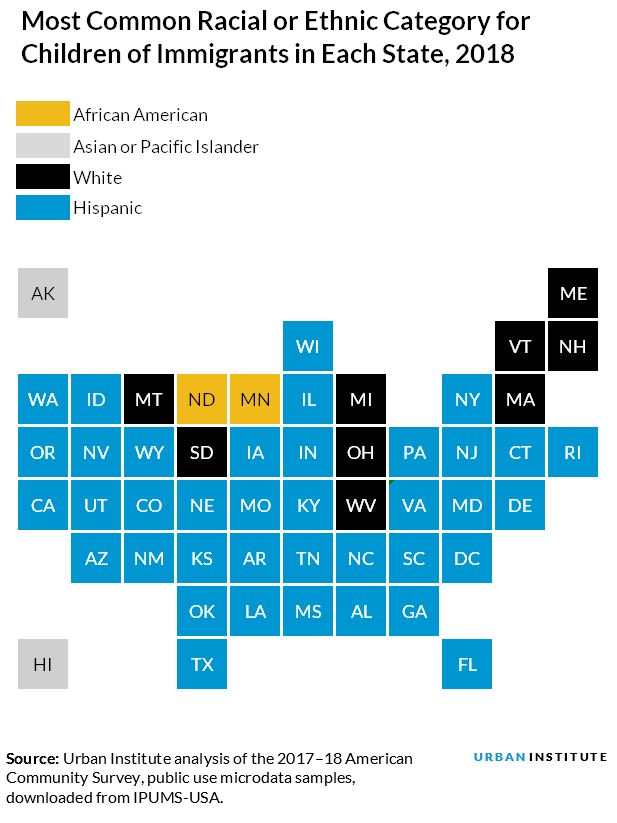
<p>A young girl waits in line with her parents after a Naturalization Ceremony at the El Paso County Coliseum on April 18, 2019 in El Paso, Texas. Photo by PAUL RATJE/AFP via Getty Images.</p>
One of four children in the US—more than 18 million kids in all—have at least one foreign-born parent.
These children of immigrants account for an increasing number of America’s children, and they will help make up the next generation of workers and taxpayers. Their ability to learn, grow, and meet their full potential is linked to the future of each state and the nation as a whole.
Federal and state policy decisions and the priorities they reflect will affect not only children of immigrants but also the next generation of Americans.
The characteristics and realities of children of immigrants and their families are diverse and vary from state to state. Just as there is no single immigrant story, there is no single story for children of immigrants. Yet most children of immigrants share a strong tie to the US and have become a part of the future of every state.
Children of immigrants are diverse
Children of immigrants come from a variety of backgrounds. They are diverse in terms of race and country of origin. And the picture becomes more complex when looking at individual states.
Nationally, more than half of children of immigrants are Hispanic (54 percent in 2018, down slightly from a high of 57 percent in 2010 and 2011), but the share in different racial and ethnic groups varies by state and metropolitan area.
Children of immigrants are most likely to be white in northern New England states, Asian and Pacific Islander in Alaska and Hawaii, and African American in Minnesota and North Dakota. Hispanic children of immigrants are prevalent across many states but are most common in southwestern, southern, and western states.

Similarly, immigrant parents’ country of origin varies by state and region, which has implications for policymaking because it influences language access and cultural competence.
In California, 52 percent of children of immigrants in 2018 had immigrant parents from Mexico, compared with only 8 percent in New York. (When parents are from different regions, the child is assigned the primary parent’s region of origin.)
Additionally, states with the greatest growth in the share of children of immigrants are not always traditional immigrant destinations. Some new destinations such as North Carolina and Nebraska have seen some the greatest growth in the share of children of immigrants (increased from 12 to 19 percent and 11 to 16 percent, respectively, from 2006 to 2018).
By contrast, Texas, a traditional immigrant destination, experienced a smaller increase over this period (31 to 34 percent), and their share in California—the state with the most and highest share of children of immigrants—actually decreased from 49 to 47 percent.
Most children of immigrants’ families have deep ties to the US
Across all states, children of immigrants and their families have developed deep ties to the US and have put down roots in their states and communities. The vast majority of children of immigrants (91 percent nationally and more than 80 percent in each state) are US citizens, and the majority have at least one US-citizen parent.
Of the 62 percent—more than 11 million—children of immigrants with a US-citizen parent nationally, around 5.1 million had both an immigrant and a US-born parent, and approximately 6.5 million had one or more immigrant parents who had become naturalized citizens.
Most children of immigrants’ families are also not recent arrivals; more than three-quarters of all US children of immigrants and more than 60 percent in each state have immigrant parents who have lived in the US for at least a decade. The share of children of immigrants whose parents have been in the US a decade or longer has also increased in recent years, from 68 percent nationally in 2006 to 76 percent in 2018.
Current threats to children of immigrants—and our future
Immigration enforcement and some immigration policies can risk family stability and overall well-being for children of immigrants.
Immigrant families have reported avoiding and being afraid of participating in public programs that citizen children are eligible for, despite their demonstrated benefits, because of the current policy climate. This can threaten the future of the US and different states because these children will help make up the next generation of workers and taxpayers.
Although children of immigrants are diverse across states, actions affecting these children matter for all American children. Attitudes about and investments in children can affect all America’s children, including children of immigrants, and consequently, the futures of states, localities, and the US overall.
Understanding America’s children
Exploring the children of immigrants in your state or metropolitan area can help foster better understanding of their unique characteristics, the programs that can support them and other children, and the potential implications and consequences of federal, state, and local policies and program decisions on their future.
View a snapshot of children of immigrants in your state, explore their characteristics and trends over time in each state and the most populous 100 metropolitan areas, and download and explore data on children of immigrants and other children for yourself.
Let’s build a future where everyone, everywhere has the opportunity and power to thrive
Urban is more determined than ever to partner with changemakers to unlock opportunities that give people across the country a fair shot at reaching their fullest potential. Invest in Urban to power this type of work.